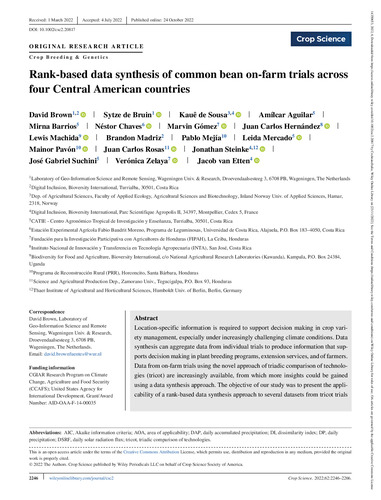Rank-based data synthesis of common bean on-farm trials across four Central American countries
Location-specific information is required to support decision making in crop vari-ety management, especially under increasingly challenging climate conditions. Datasynthesis can aggregate data from individual trials to produce information that sup-ports decision making in plant breeding programs, extension services, and of farmers.Data from on-farm trials using the novel approach of triadic comparison of technolo-gies (tricot) are increasingly available, from which more insights could be gainedusing a data synthesis approach. The objective of our study was to present the appli-cability of a rank-based data synthesis approach to several datasets from tricot trialsAbbreviations:AIC, Akaike information criteria; AOA, area of applicability; DAP, daily accumulated precipitation; DI, dissimilarity index; DP, dailyprecipitation; DSRF, daily solar radiation flux; tricot, triadic comparison of technologies.This is an open access article under the terms of theCreative Commons AttributionLicense, which permits use, distribution and reproduction in any medium, provided the originalwork is properly cited.©2022 The Authors. Crop Science published by Wiley Periodicals LLC on behalf of Crop Science Society of America.2246wileyonlinelibrary.com/journal/csc2Crop Science.2022;62:2246–2266.BROWNET AL.2247Crop Scienceto generate location-specific information supporting decision making in crop varietymanagement. Our study focuses on tricot data from 14 trials of common bean (Phase-olus vulgarisL.) performed between 2015 and 2018 across four countries in CentralAmerica (Costa Rica, El Salvador, Honduras, and Nicaragua). The combined data of17 common bean genotypes were rank aggregated and analyzed with the Plackett–Luce model. Model-based recursive partitioning was used to assess the influenceof spatially explicit environmental covariates on the performance of common beangenotypes. Location-specific performance was predicted for the three main grow-ing seasons in Central America. We demonstrate how the rank-based data synthesismethodology allows integrating tricot trial data from heterogenous sources to providelocation-specific information to support decision making in crop variety manage-ment. Maps of genotype performance can support decision making in crop varietyevaluation such as variety recommendations to farmers and variety release processes.

